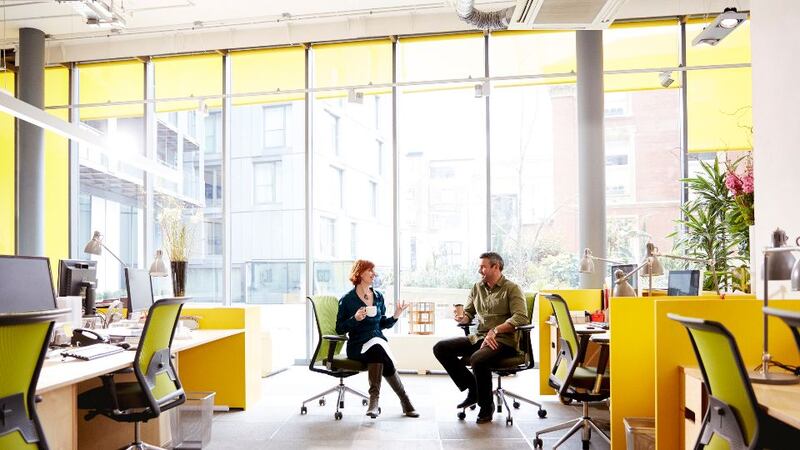Modern workplaces are changing, and not just in terms of their design and layout. The message that a happy, healthy workforce is also a productive one has been received and understood leading to a much greater focus on workplace wellness.
The research shows that employers who help staff achieve a better balance in their working lifestyle are rewarded with a happier, more productive workforce. They also benefit from more loyal employees and are more appealing to new recruits.
Improved health and wellbeing also has a direct impact in terms of reducing absenteeism due to illness. With one estimate putting the number of days lost in Ireland every year due to absenteeism at 11 million at a cost of €1.5 billion or €818 per employee, any reduction would have major benefits for employers.
Simply spending more on health and wellness initiatives won’t necessarily deliver these benefits, however. The latest statistics indicate that just one fifth of Irish employers have formal, structured employee wellness programmes. Many of those who do not may well be actually spending more but the activity is ad hoc and consequently unfocused.
The old business adage goes that you can’t manage what you can’t measure. Without a structured approach you can’t assess what impact the programme is having or if it’s doing your employees any good at all. It is also extremely difficult to get the balance right if you don’t have the full picture. That’s why almost all of the world’s leading companies now have employee wellbeing programmes fully integrated into their overall business strategies.
That is no surprise as the links between wellness, productivity and job performance are well established. A study carried out for the UK government found that there is a considerable amount of evidence to indicate that there is a positive association between wellbeing and an employee's job performance.

The same study pointed to the need for a whole workplace approach to wellbeing instead of tackling it an individual level. It found that if a significant number of employees in a workplace do not feel well in themselves this is likely to have a spill over effect on their colleagues and have a negative impact on the performance of the whole organisation.
Another UK study, this time of 55 companies with structured wellbeing programmes showed that 45 of them had reduced absenteeism by an average of between 30 per cent and 40 per cent, while 18 of them had reduced staff turnover by an average of between 20 per cent and 25 per cent.
Also in the UK, research carried out in association with Cambridge University, found that lack of sleep, financial concerns and excessive caring responsibilities for family members or relatives had a negative impact on workplace productivity.
It is little wonder then that wellness initiatives have become an increasingly common element of 21st century company life, where the sight of employees setting out on a lunchtime run, or even receiving massages at their desks, no longer provokes the slightest surprise.
These activities are just two manifestations of the wellness revolution which is gathering pace in workplaces around the world. Employers, increasingly aware of the benefits of a healthy workforce and the need to attract and keep talent, are enhancing their wellness programmes with a suite of incentives that can include anything from regular medical check-ups and treatments to healthy eating initiatives as well as fun stuff like games rooms, bars, and canteens stocked with free snacks and treats.

Many employers are also taking positive steps towards creating an environment where mental health issues are no longer stigmatised and stress management and emotional wellness services are part of the standard programme. It is also not uncommon to see yoga and aerobics classes being held on site while a growing number of companies are partnering with local gyms and other physical fitness providers.
Perhaps driven by the changing aspirations and motivations of the millennial generation there is now an acknowledgement of employees’ whole of life needs. Regular review appraisals, which traditionally focused on assessing employee productivity, will often now include a segment to address an employee’s general wellbeing.

Work life balance is also a priority. If long commuting times are affecting work performance or creating tensions at home, flexible working arrangements can be offered to solve or at least alleviate the problem. Many employers are offering imaginative solutions to meet the needs of their employees who face childcare issues during school holidays.
These solutions have a positive impact on loyalty. Research carried among Irish employees earlier this year found that 49 per cent of them would consider leaving an employer who doesn’t show an interest in their health and wellbeing while 60 per cent are more likely to stay longer with an employer who does show an interest.
The benefits don’t stop there. The World Health Organisation lists a range of benefits to be had from workplace wellness programmes for both employees and organisations. For the organisation these include improved staff morale, reduced staff turnover, reduced absenteeism, increased productivity, and reduced healthcare and insurance costs.
Employee benefits include enhanced self-esteem, reduced stress, improved morale, increased job satisfaction, improved health, and improved sense of wellbeing.
All the evidence shows that a having a happy, healthy workforce makes employers more attractive to new recruits and leads to improved productivity, reduced absenteeism, increased employee loyalty, reduced turnover in staff, lower healthcare and insurance costs, and improved organisational performance. It’s time to get with the programme.

A note from Vhi about Rebalance
We know that when employees nurture both body and mind it can lead to happier employees and better business results. That’s why our health and wellbeing programme is focused on engaging employees in a culture of wellbeing both in work and at home.
Our approach at Vhi is holistic and proactive, with programmes specifically designed to meet each employee’s needs. We offer services which are accessible by all, sustainable in everyday life and enjoyable too.
Wellbeing with Vhi, is all about two pillars; body and mind. In fact, the old adage of healthy body, healthy mind is more relevant today than ever as the two largest categories of work-related illness are musculoskeletal disorders and stress, anxiety and depression.
Our programmes are accessible to all (not just the superfit), which in turn leads to greater engagement and sustainability. Choose from our range of programmes, including trending topics such as diet and nutrition, fitness and emotional wellbeing.
If you'd like to find out more about Vhi Rebalance call 056 7775800 or visit our website to arrange for one of the Vhi team to get in contact with you.











